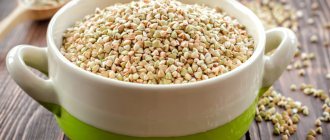Photo from the site: Poleznenko.ru
Humanity learned about buckwheat a very long time ago; scientists believe that the acquaintance took place at least six thousand years ago, and this, you see, is a considerable period of time. Much water has passed under the bridge since then; first, buckwheat porridge became popular in the Himalayas, and only two thousand years ago it finally reached the Slavic lands. There are two main types of buckwheat that end up on the tables of modern people, these are brown and green buckwheat, the benefits of which for the body are simply invaluable, which even experienced scientists, and not just traditional healers, agree with. Let's figure out what this product is, why it is valuable and what substances it contains, why it has earned the corresponding reputation, and why many nutritionists recommend using it for weight loss.
Chemical composition and calorie content
Green buckwheat is not a special plant. We are talking about the seeds of the same well-known buckwheat (which, by the way, has nothing to do with Greece, just like the walnut), peeled, but not subjected, as usually happens, to preventive treatment - at best thermal, in the form of steaming or frying, at worst - chemical, when, with the “noble” goal of destroying bacteria, fungi and other pathogenic microorganisms, the raw materials are deprived of almost all vitamins and other beneficial nutrients.
Important! Oddly enough, due to the fact that the grains were not roasted, their shelf life remains the same as that of regular cereals - it is believed that both of these products should be consumed within 1.5–2 years.
Thus, we are talking about “live” grain, in which the viability of the embryo is preserved, which means that green buckwheat can be consumed both as a regular porridge and in sprouted form, the latter option is considered more useful.
In terms of calorie content, brown and green buckwheat differ little from each other: 100 g of boiled buckwheat contains from 93 to 110 kcal. Some sources indicate more significant figures (308–330 kcal), but such discrepancies are easily explained if you consider that buckwheat porridge is usually generously flavored with butter, and any fat means additional calories.
As for the energy value of the product, green buckwheat contains:
- proteins - 15%;
- fat - 2.5%;
- carbohydrates - 62%.
We recommend that you find out how sprouted green buckwheat is beneficial for the human body.
The carbohydrate composition of the kernel is represented by complex and simple saccharides, and there are approximately 35 times more of the former (we are talking primarily about starch) in the grains than the latter. It is the presence of a high content of “slow” carbohydrates that determines the usefulness of the product, especially for those who are watching their weight.
Among other biologically active components of cereals, it is worth highlighting:
- vitamins - A, B1, B2, B6, B9, E, K, PP;
- minerals - iron, magnesium, phosphorus, potassium, sulfur, iodine, fluorine, silicon, cobalt, manganese, molybdenum, zinc, etc.;
- organic acids - malic, oxalic, citric;
- amino acids - about two dozen, including lysine, which is absent in roasted grains, as well as threonine, tryptophan, leucine, isoleucine, cystine, tyrosine, valine, proline, glycine, alanine, histidine, arginine, glutamic and palmitic acids.
Green buckwheat contains fiber, which has a beneficial effect on intestinal function, and in terms of dietary fiber content, buckwheat is almost twice as high as other popular cereals.
Another valuable property that distinguishes green buckwheat from most cereals is the complete absence of gluten, which is also called wheat protein or gluten. Many people have an individual intolerance to this plant protein (this pathological condition is called celiac disease), and therefore are forced to adhere to a strict gluten-free diet; for them, buckwheat is a real godsend. However, it should be noted that fried buckwheat grains also do not contain gluten, and this “harmful” protein is not found in rice, millet and millet.
Green buckwheat: composition
Not everyone knows what green buckwheat is, because it rarely appears on store shelves. Although, in the last few years it has been returning to the assortment of retail outlets. And once upon a time, raw buckwheat grains were a common part of the menu of people who lived at the beginning of the last century. But the industry turned the green grains into fried ones. Yes, this made buckwheat taste better. But this did not add any benefit to her.
Green buckwheat has a very rich and valuable composition. Grains that have not undergone heat treatment contain more useful living substances. It includes the following elements:
- acids: oxalic, folic, gallic, caffeic, chlorogenic, pyrocatechol, maleic, citric, malic and linoleic;
- calcium, iodine, phosphorus, rutin, potassium;
- antioxidants, 18 amino acids;
- vitamins E, PP, B, P.
BJU ratio for green buckwheat, vitamin and mineral composition per 100 g
| Nutrient | Quantity in raw | Amount boiled (without salt) |
| Calories, kcal | 310 | 110 |
| Fats | 3,3 | 1 |
| Proteins | 12,6 | 4 |
| Carbohydrates | 62 | 21 |
| Water | 14 | 14 |
| Alimentary fiber | 1,3 | 1,3 |
Green buckwheat also contains vitamins that are good for health.
| Vitamin name | Quantity in raw | % Daily Value for an Adult | Amount in boiled | % Daily Value for an Adult |
| A (Retinol equivalent), mcg | 6 | 0,7 | 6 | 0,7 |
| B1 (Thiamin), mg | 0,4 | 26,7 | 0,4 | 26,7 |
| B2 (Riboflavin), mg | 0,2 | 11,1 | 0,2 | 11,1 |
| B6 (Pyridoxine), mg | 0,4 | 20 | 0,4 | 20 |
| B9 (Folic), mcg | 31,8 | 8 | 31 | 7,8 |
| E (TEQ), mg | 6,7 | 44,7 | 6 | 40 |
| PP (Niacin equivalent), mg | 4,2 | 21 | 4 | 20 |
Among other things, green buckwheat is a treasure trove of minerals.
| Name of micro-, macroelements | Quantity in raw | % Daily Value for an Adult | Amount in boiled | % Daily Value for an Adult |
| Calcium, mg | 20,7 | 2,1 | 20 | 2 |
| Magnesium, mg | 200 | 50 | 200 | 50 |
| Sodium, mg | 3 | 0,2 | 3 | 0,2 |
| Potassium, mg | 380 | 15,2 | 380 | 15,2 |
| Phosphorus, mg | 296 | 37 | 290 | 36,3 |
| Sulfur, mg | 88 | 8,8 | 88 | 8,8 |
| Chlorine, mg | 34 | 1,5 | 34 | 1,5 |
| Iron, mg | 6,7 | 37,2 | 6 | 33,3 |
| Zinc, mg | 2,05 | 17,1 | 2 | 16,7 |
| Manganese, mg | 1,56 | 78 | 1 | 50 |
| Copper, µg | 640 | 64 | 640 | 64 |
| Iodine, mcg | 3,3 | 2,2 | 3 | 2 |
| Fluorine, mcg | 23 | 0,6 | 23 | 0,6 |
| Silicon, mg | 81 | 270 | 81 | 270 |
| Cobalt, µg | 3,1 | 31 | 3 | 31 |
| Molybdenum, mcg | 34,4 | 49,1 | 34 | 48,6 |
| Chromium, µg | 4 | 8 | 4 | 8 |
The benefits of sprouted buckwheat
Green buckwheat itself has the full range of beneficial properties inherent in fried grains, however, in addition to this, the standard list is supplemented by the healing effect of sprouts, which can be obtained from “live” grains.
Important! Sprouting any grains before consuming them greatly increases the original healing properties of the product.
This interesting feature has a completely scientific explanation. The fact is that in nature, a seed that has fallen into the ground usually does not begin to germinate immediately, but waits for conditions favorable for this, that is, next spring. During this period, all the vital juices contained in the grain shell are in a “canned”, dormant state.
Once in conditions suitable for germination (warm and humid environment), the seed comes to life, and active processes begin inside it aimed at maximizing the mobilization of internal potential.
All nutrients accumulated during the “wintering” period transform into a form convenient for rapid absorption and begin to interact with each other, reinforcing and multiplying the value of each other - the so-called synergy effect. On the contrary, those components that contributed to maintaining the vitality of the seed, preventing it from germinating ahead of time, slowing down and blocking this process, are destroyed and neutralized.
Thus, if you eat not just porridge, but pre-sprouted grains, the body with such a product will receive the maximum amount of nutrients in the form most suitable for absorption, and will not receive anything that is potentially harmful to health.
- In particular, green buckwheat with sprouts:
- stimulates metabolic processes in the body, promotes the removal of heavy metal salts, products of incomplete redox reactions (antioxidant effect), bad cholesterol and other harmful substances;
- has an immunostimulating and immunomodulatory effect, reduces the manifestations of allergies, which, as is known, is an autoimmune pathology;
- significantly improves intestinal function, normalizes its microflora;
- increases overall endurance, including due to the rich vitamin composition (interestingly, ascorbic acid, almost completely absent in buckwheat grains, is synthesized at the time of their germination, the content of tocopherol and B vitamins also increases);
- has a beneficial effect on the functioning of the digestive system, especially the pancreas, and promotes the healing of stomach and duodenal ulcers.
Speaking about the benefits of green buckwheat, you need to pay attention to one more point. Despite the fact that the chemical composition of the grain remains virtually unchanged depending on the degree of processing of the grains, “live” grains usually cost much more. This is explained by the fact that raw grains are much more difficult to peel than fried grains (this phenomenon can be easily observed at home using the example of peanuts).
It will be useful for you to read about the benefits, harms and contraindications of green buckwheat for human health.
But consumers simply don’t want to pay extra money, so green buckwheat is usually sold not in the general departments of supermarkets, but in the aisles of so-called “organic food products.”
The products presented here are grown without the use of pesticides and genetic engineering, which in itself makes them healthy.
Sprouted buckwheat grains are a universal dish; everyone can and should eat it, regardless of age and gender. However, there are nuances when using the product by men and women.
For men
The antioxidant properties of tocopherol and other components included in the cereal, among other important qualities, ensure the strengthening of blood vessels and heart muscle, which is something that men over 40 should definitely keep in mind.
Did you know? Statistical studies conducted by specialists from the Pomeranian Medical University (Szczecin, Poland) and recently published in the journal Science in Poland show that cardiovascular diseases in men, on average, begin to occur 10 years earlier than in women, but mortality from These ailments are higher among the fair sex - 55% versus 43% among men.
In addition, scientists name hypomagnesia, a lack of magnesium in the body, among the causes of early cardiovascular pathologies. This element is a catalyst for calcium, sodium and potassium metabolism, maintaining the amount of these elements in the correct ratio.
Another important function of magnesium is improving blood flow and lowering blood pressure, which means preventing hypertension. Buckwheat bioflavonoids have a beneficial effect on liver function, which is why buckwheat is directly indicated for men who are prone to drinking alcohol. The emerging “beer belly” is a direct indication for leaning on buckwheat porridge, since excess weight is one of the factors leading to the development of atherosclerosis, ischemia, anemia, leukemia and type 2 diabetes.
The amino acid and vitamin complex of sprouted grains normalizes hormonal balance and stimulates the genitourinary system, prevents the appearance of symptoms of prostatitis, and improves potency.
For women
Buckwheat, especially sprouted buckwheat, promotes cell regeneration, slows down the aging process, which provides the already mentioned antioxidant properties. In addition, the product noticeably improves the quality of skin and hair, which is greatly facilitated by the presence of an element such as silicon in it.
This mineral stimulates collagen production.
Useful properties of “live” buckwheat
The benefits to the body are due to the chemical composition of this “live” product. Effects of regular consumption of products with green buckwheat:
- The skin tightens and its condition improves, blood vessels are strengthened. This effect is associated with the silicon content, which stimulates collagen synthesis.
- The risk of cardiovascular diseases is reduced. This property of green buckwheat is associated with the optimal ratio of the minerals magnesium, calcium, potassium and copper, as well as vitamin PP.
- Bones are strengthened and the condition of tooth enamel is improved. Phosphorus, fluorine, copper and manganese in green buckwheat help mineralize bone tissue and restore bones after fractures.
- The hematopoietic function of the body is enhanced and the barrier function of the liver is restored. Iron, cobalt and B vitamins are required by the body to synthesize red blood cells. Iron is also part of the oxidative enzymes of the liver, which neutralize substances dangerous to the body. Cobalt promotes weight loss as it activates the breakdown of lipids.
- The risk of cancer is reduced and body tissues are rejuvenated. This effect is achieved thanks to the content of antioxidant vitamins: vitamins E and A, as well as molybdenum, which is involved in DNA renewal and the exchange of sulfur-containing amino acids.
- Digestion improves. Dietary fiber stimulates the motility of intestinal smooth muscles.
- Immunity is strengthened. Thanks to B vitamins and vitamin PP, as well as easily digestible amino acids, the body's defenses are activated.
- The condition of hair and nails improves. Thanks to a complex of minerals and vitamins, the synthesis of keratin protein, a structural component of hair and nails, is activated.
- The nervous system is strengthened. B vitamins and phosphorus are required by the body to synthesize and maintain healthy nerve cells. 100 g of green buckwheat contains 1.03 g of the amino acid glycine, a precursor of a neuroactive substance responsible for the activity and relaxation of the cerebral cortex and the maintenance of daily biorhythms.
- Humoral regulation of metabolism is restored. Iodine is a trace element for maintaining thyroid health. Chromium, zinc, manganese and copper are cofactors of enzymes responsible for the normal functioning of the adrenal glands, reproductive glands and pancreas.
Contrary to the assurances of advertising media, green buckwheat cannot cure kidney disease, restore the liver or cure gastritis and diabetes, but products and dishes based on this cereal can support the body during colds and reduce weight in obesity.
Green buckwheat is a food product that can be included in the diet of patients with special nutritional requirements. For example, it is included in the menu for diabetes (but does not treat it), celiac disease and other metabolic disorders.
Contraindications
Green buckwheat itself has practically no contraindications, but in its sprouted form the product should be treated with caution by those who suffer from pancreatitis, stomach or duodenal ulcers. During the period when the disease is in the acute stage, it is better to avoid eating sprouts, replacing them with regular porridge.
Another conditional contraindication is increased blood clotting. The kernel, both green and brown, contains rutin, which helps thicken the blood and thus increases the risk of blood clots.
Important! Sometimes, after the first intake of sprouted grains, unpleasant symptoms such as dizziness, general weakness or diarrhea occur. As a rule, after a few days, when the body adapts to the unusual food, these side effects disappear on their own.
If sprouted grains can provoke gastric disorders, then ordinary porridge cooked from dry kernels, especially when consumed excessively in its pure form, without oil, gravy and other similar “lubricating” additives, sometimes causes constipation.
It must be borne in mind that sprouted buckwheat is not compatible with all products; in particular, it is better not to use it in combination with:
- It must be borne in mind that sprouted buckwheat is not compatible with all products; in particular, it is better not to use it in combination with:
- milk and any types of milk;
- honey, propolis, beebread, royal jelly;
- some medicinal herbs, for example, Rhodiola rosea (golden root);
- food additives such as mumiyo.
Selection and storage
High-quality green buckwheat has a greenish tint and is light in shape. The cereal should not have any foreign odors. If it smells like mold, it means the product was stored at high humidity and is unfit for consumption, as it can cause harm to the body. The best grains are those produced in Europe (Austria and Germany).
Buckwheat should be stored in an airtight container in a dark, dry place. After purchasing, it is advisable to consume the cereal within one month.
Green buckwheat, the benefits of which are described in the article, is a unique useful product that can improve the condition of the body, slow down the aging process, lose excess weight and even slow down the growth of a malignant tumor. Try introducing this unique product into your diet and you will quickly notice the results!
How and with what you can cook sprouted buckwheat
In order for sprouted green buckwheat grains to bring not only benefits, but also pleasure, experienced housewives use many original and tasty recipes. Below are the most successful of these dishes.
Salad with pink tomatoes
Before you begin your culinary creativity, you need to do the basic preparatory work - sprout the green buckwheat kernel. This process will take about a day, so you need to organize it in advance.
Check out the properties of buckwheat flour with kefir for weight loss.
There are several ways to obtain buckwheat sprouts. In any case, the cereal should be thoroughly washed in several waters and all debris that has floated to the surface should be removed, including empty buckwheat seeds (if the grain does not sink, it does not contain a viable embryo, it is not suitable for the task at hand).
Then the wet kernel can be placed on one side of a piece of gauze folded in several layers, covered with the other half on top and left at room temperature for a day, spraying the fabric from time to time so that it does not dry out.
This method has a right to exist, but it produces a very small number of sprouts, so it is better to first soak the cereal for 3–12 hours in a large amount of clean water. After a while, the water is drained, and the swollen cereal is washed again several times to get rid of excess mucus formed during the soaking process.
Did you know? With the help of buckwheat husks you can improve your sleep, it’s not for nothing that pillows are filled with it to treat insomnia, because they believe that it has a positive effect on biological points in the body
.
Now comes the next stage - germination itself. It is best to do this using the technology for preparing microgreens: simply pour the swollen kernels into a plastic container and, without filling them with water, leave them under a lid in a well-lit place. The sprouts will appear in about a day, but during this time it is better to rinse the kernel 1-2 times, otherwise the finished product will be very slimy and, in addition, will acquire a not very pleasant musty “smell.”
After the grains have sprouted, it is better to immediately cook and eat them. It is possible to store sprouts in the refrigerator for 72 hours, but you need to keep in mind that in this case the nutritional value of the finished product is still largely lost.
Sprouted buckwheat is supposed to be consumed raw, but not everyone likes its specific taste, so preliminary heat treatment is allowed, although it is considered undesirable. However, there is no need to cook sprouted buckwheat like porridge. It is enough to pour the cereal with water at the rate of 1 part grains to 2.5 parts water, bring to a boil, remove from heat and leave for 15 minutes.
Find out also about the features of the watermelon-buckwheat diet.
To prepare a salad with tomatoes and buckwheat sprouts you will need:
- boiled sprouted buckwheat: 1 cup;
- pink tomatoes: 2–3 pieces (medium size);
- boiled beets: 1 piece;
- soy sauce: 30 ml;
- fresh herbs: 5–10 sprigs.
- salt, pepper: to taste.
Preparing the salad is extremely simple: cut the tomatoes and beets into small slices, mix with boiled cereal, add chopped herbs, salt and pepper, sprinkle with soy sauce and serve immediately.
Salad with bread
Ingredients:
- boiled sprouted buckwheat: 1 cup;
- bread (rye or buckwheat): 8 pcs.;
- vegetable oil (preferably linseed or sesame): 30 ml;
- fresh herbs: a small bunch;
- lemon: ½ pcs.;
- salt: to taste.
Crumble the bread with your hands into a fraction of small crackers, chop the greens, mix all the ingredients, season with a mixture of vegetable oil and freshly squeezed lemon juice, and add salt.
Summer salad
Sprouted buckwheat salad can be prepared with the addition of any seasonal vegetables - tomatoes, cucumbers, bell peppers, onions, etc. To enrich the dish with vitamins, it is also good to add any lettuce leaves, or even better, a mix of them. The vegetable group is cut into not too small slices, the salad is torn by hand, sprouted cereals are added to the resulting mixture and seasoned.
For refueling, you can use it in any combination:
- soy sauce;
- lemon or orange juice;
- vegetable oil;
- Dijon mustard;
- liquid honey.
Porridge with crispy onions
To prevent sprouted buckwheat porridge from seeming so lean and boring, you can mix it with onions fried until crispy. The dish will turn out to be less dietary, but incredibly tasty, if you first fry the bacon cut into strips in a frying pan, then discard it on a paper towel, and put the onions in the remaining fat, then season the porridge with cracklings and caramelized onions.
With cucumbers and arugula
As was said, sprouted green buckwheat goes well with any fresh vegetables and herbs, but one of the most successful combinations is a pair of cucumbers plus arugula. Surprisingly, it is this type of salad leaves that creates an absolutely ideal and harmonious taste with cucumber, while buckwheat sprouts act in the dish as a neutral component that does not upset the balance and overall impression, but enriches the salad with vitamins and beneficial minerals.
We recommend reading about buckwheat noodles.
Fresh avocado can perform the same role; it is also often added to salads with cucumbers, arugula and buckwheat. The cooking principle is standard: all ingredients are mixed and seasoned with any light sauce to taste. Sour cream and especially mayonnaise are not suitable for this healthy and low-calorie dish, but low-fat yogurt may be quite appropriate. In this case, the salad will taste slightly reminiscent of the famous Greek tzatziki, especially if you add a little crushed garlic to it.
With almonds
Another healthy product that goes very well with sprouted grains is nuts. In particular, almond ones.
Did you know? In Japan, which ranks 9th in the world in buckwheat production, no one consumes this product in the form of cereal. Soba (the local name for the cereal) is used here exclusively to make a special noodle that is eaten by first dipping in tsuyu, a spicy mixture of rice wine, fish stock and soy sauce.
For example, to prepare an original salad, you can use the following list of ingredients:
- green sprouted buckwheat: 1 cup;
- almonds: 10–15 pcs.;
- sweet pepper: 1 pc.;
- green onions: 2–3 feathers;
- celery stalk: 1 pc.;
- garlic: 2–3 cloves;
- seaweed: 1 cup;
- vegetable oil (linseed, olive, sesame): 30 ml;
- fresh herbs: 10–15 stems;
- lemon: ½ pcs.
Soak the almonds for several hours, chop them with a knife to the size of buckwheat, and mix with the sprouts. Add finely chopped vegetables, seaweed and herbs, season with oil and freshly squeezed lemon juice. Salt is not used in the recipe, since seaweed is a fairly salty product, but if desired, the finished dish can be slightly salted to taste.
Cream soup with avocado and cucumber
From cucumber, avocado and green buckwheat you can prepare not only a salad, but also a very unusual puree soup. The beauty of this dish is that it is prepared without heat treatment, and therefore all its ingredients completely retain their vitamin composition.
Read also the health benefits and harms of buckwheat flour.
To prepare the soup you will need:
- green sprouted buckwheat: 1 cup;
- fresh avocado: 1 piece;
- fresh cucumbers (gherkins): 5–6 pcs.;
- purified water: 500 ml;
- lemon: 1 pc.;
- salt, pepper: to taste;
- fresh herbs: 1 small bunch;
- peeled sunflower seeds or sesame seeds: 1 handful (for decoration).
Peel the avocados and cucumbers and chop them randomly. Place in a blender bowl, add the sprouted cereal and blend until smooth. Add water, salt and pepper, season with freshly squeezed lemon juice. Before serving, sprinkle with finely chopped herbs and seeds.
Table of buckwheat BCJU (per 100 g of product)
The table below details how much protein is in boiled and raw buckwheat, as well as the exact amount of other important components in it.
| Boiled buckwheat | Raw buckwheat | |
| Squirrels | 3,6 | 12,6 |
| Fats | 2,2 | 3,3 |
| Carbohydrates | 17,1 | 57,1 |
| Cellulose | 1 | 11,3 |
| Water | 72,2 | 14 |
Calorie content of boiled buckwheat with butter per 100 grams
Oil added to the prepared dish softens the taste of porridge and makes it richer. In this case, the number of calories in boiled buckwheat increases. The exact nutritional value of porridge with butter depends on how the buckwheat is cooked (in water/milk), whether salt is added to it, and what kind of oil (sunflower/butter) in what quantity was added to the dish.
So, how many calories are in buckwheat cooked in the usual way? On average, in cereals seasoned with oil, the calorie level reaches from 140 to 160 kcal (per 100 g of product). An accurate calculation of nutritional value must be done independently.
To do this, you just need to add to the initial calorie content of the cereal (boiled without salt) the calorie content of the ingredients added to it.
How many calories are in buckwheat steamed with boiling water without salt?
The main dish of several diets at once is buckwheat steamed with boiling water. In this case, such porridge is prepared, as a rule, without salt. In such a pure form, the beneficial components contained in the cereal are not reduced by half (as happens during conventional cooking).
A special advantage of this method of preparation is the type (consistency) of the porridge. Buckwheat turns out crumbly and soft. It's quite simple to prepare:
- Rinse the buckwheat;
- Pour cold water over the cereal for 2-3 hours;
- Drain;
- Pour boiled water over the buckwheat (there should be 2 times more water);
- Place the container with the cereal in a warm place and/or cover it with a towel;
- Leave the buckwheat to steep overnight.
In the morning, buckwheat prepared in this way can be heated in the microwave or on the stove and immediately started eating. Those who are interested in the answer to the question of how many calories are in steamed buckwheat without salt will be pleasantly surprised. On average, the calorie content of such a product does not exceed 105 kcal (per 100 g).
Calorie content of boiled buckwheat without salt per 100 grams
The main difference between boiled and steamed buckwheat is the amount of useful components. At the same time, the calorie content of the resulting dish is almost identical.
So, buckwheat boiled without salt contains from 90 to 105 kcal (their exact amount depends on the specific type of cereal).
Calorie content of buckwheat with milk per 100 grams
Buckwheat with milk, of course, will have a nutritional value that is an order of magnitude higher than its lean counterpart. The exact number of calories in such buckwheat depends on the fat content and composition of the milk itself.
Therefore, the value of a dish should be calculated during its immediate preparation (taking into account information about the calories in milk and its amount added to the porridge).
On average, the calorie content in one serving of buckwheat with milk varies from 150 kcal to 175 kcal.
How to properly eat sprouted green buckwheat
Despite all its beneficial properties, sprouted buckwheat is a high-carbohydrate product, so it is still better not to use it as a mono-diet. The best time to eat sprouts is in the morning. For dinner, they can be served to people suffering from constipation; in other cases, due to the high content of dietary fiber, which stimulates intestinal motility, it is not advisable to eat sprouted grains at night.
Did you know? Until recently, the British grew buckwheat exclusively as a honey plant, and they did not so much consume the honey themselves as export it to neighboring France. After harvesting, local farmers fed the cereal itself to pheasants.
The appropriate time for a low-calorie dish, but at the same time rich in vitamins and microelements, is a snack between main meals in the case of fractional meals, when the patient is recommended to eat little and often. For lunch, sprouts are suitable in combination with bacon, minced meat, mushrooms, cheese or poultry, or for dessert - in the form of a smoothie with the addition of fruits and nuts.
Various candies and other sweets are prepared from green buckwheat with sprouts. It is believed that such dishes are compatible with the ideology of a healthy lifestyle and will not harm the figure. But for this rule to work, sugar should not be present in recipes, since it completely neutralizes the healing properties of sprouts. Raisins, prunes or banana pulp should be used as a sweetener in this type of dessert.
As is clearly seen from the above recipes, sprouted buckwheat can be considered as an independent dish or as an ingredient for vegetable salads or light soups, but here you also need to keep in mind that nutritionists categorically do not recommend eating fresh vegetables before bed. There are no special restrictions on the amount of sprouted kernels eaten during the day - in principle, the product can be consumed in any portions and doses if the body reacts normally to it.
But first you need to accustom yourself to unusual food, so it’s better to start eating sprouts in small quantities, for example, adding 1-2 tsp. in your favorite vegetable salad.
How to cook
Green buckwheat is not only sprouted, but a very tasty porridge is prepared from it. Perhaps those who try it for the first time will not even understand that it is buckwheat. It is so tender and so different from the brown buckwheat we are used to that after trying it at least once, you may not want to continue eating “useless” brown buckwheat.
Before cooking, soak green buckwheat in water overnight. If you urgently need to cook buckwheat, then fill it with water for at least half an hour. After soaking, the water must be drained and the buckwheat must be thoroughly rinsed to remove any mucus that has formed on it.
Cooking green buckwheat is very simple. Pour the soaked and washed buckwheat into boiling water. When the water boils again, skim off the foam, turn off the heat, cover with a lid and let the porridge brew for 15-20 minutes. Buckwheat is ready when it has absorbed all the water. Buckwheat prepared in this way will retain all its beneficial substances. In addition, you can also pour hot water into a thermos with green buckwheat and leave the porridge to steep for several hours. In this case, green buckwheat will retain all its beneficial substances as much as possible. This is a convenient way to take buckwheat to work. Before lunch, buckwheat will be ready to eat.
From green buckwheat in combination with various vegetables (carrots, zucchini, beets, cauliflower, broccoli) and spices, you can prepare an incredibly tasty dish. Buckwheat loves butter very much, so add melted ghee, butter or vegetable oil to the finished porridge. See the recipe for buckwheat with moong dal here.
See the recipe for sweet buckwheat porridge for breakfast and the recipe for milky buckwheat porridge for dinner.
Features of application
Due to its numerous healing properties, green buckwheat is used not only in cooking. The product has also found equally widespread use in folk medicine and even in cosmetology.
In medicine
- Green kernel sprouts should definitely be included in your diet for patients suffering from:
- vitamin deficiency and anemia;
- hypertension;
- various pathologies of the circulatory and cardiovascular systems;
- diseases of the pancreas (magnesium plays an important role in the production of bile and its removal from the body);
- chronic constipation;
- diabetes mellitus (due to special phospholipids that sprouts are rich in, blood glucose levels are normalized);
- varicose veins (rutin and potassium contained in grains strengthen blood vessels and make them elastic, reducing stretching of veins).
The antioxidant properties of buckwheat, especially sprouted buckwheat, also suggest the anti-cancer properties of the product.
In cosmetology
The easiest way to use the beneficial properties of sprouted green buckwheat is to simply wash your face with water drained after soaking the buckwheat. From such a life-giving elixir, the skin will become tightened and elastic.
Among other beauty recipes, it is worth mentioning several face masks, which are also prepared from sprouted kernels, ground in a blender to a paste:
- Nutritional : 2–3 tsp. crushed grains, the same amount of full-fat kefir, a few drops of rosemary and ylang-ylang essential oil.
- Moisturizing: mix ground cereal with milk in equal parts, let it brew.
- Cleansing : 1 tbsp. l. pre-dried and then chopped sprouts, 3 tbsp. l. freshly squeezed cherry juice.
- Anti-aging : 2 tbsp. l. sprouted cereal gruel, egg yolk and 10–15 drops of almond oil.
All masks should be applied to previously cleansed and preferably steamed facial skin after a bath or hot shower, leave for 15–20 minutes and then rinse with plenty of cool water.
Green buckwheat has two undeniable advantages over regular brown buckwheat: its grains have not been subjected to thermal or chemical treatment, leading to the loss of a significant portion of their beneficial properties, and, more importantly, they can be sprouted. It is this method of eating cereals that is considered the healthiest, since sprouted grains actively transform all nutrients into forms that are most convenient for rapid absorption. The taste of raw kernels with sprouts, however, is a little unusual and rather bland, but it is this neutrality that makes the product a universal and very valuable ingredient for a wide variety of dishes - vegetable, meat and even dessert.
Benefits and harms
Live buckwheat grains have a lot of medicinal properties that make this product indispensable in maintaining health :
- normalization of cholesterol levels;
- improving the functioning of the circulatory system, in particular blood vessels;
- cleansing the intestines, normalizing gastrointestinal functions;
- cleansing the body of bile, waste, toxins;
- normalization of blood pressure.
If you are talking about the benefits of buckwheat in the fight against specific diseases, then this product is recommended to be consumed by people who have digestive problems. Green buckwheat is also an effective remedy for blood diseases such as leukemia or anemia.
In addition, buckwheat does not contain gluten, which is harmful to the body.
But, despite the large number of beneficial properties, green buckwheat should be consumed with caution in some cases:
- overeating can cause bloating and gas in the stomach;
- thickens the blood, so increased clotting should serve as a limitation for lovers of this cereal;
- Children's intestines are weak for buckwheat; its consumption can lead to constipation and colic.
As with any product, you need to know when to stop.











